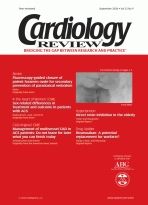Publication
Article
Cardiology Review® Online
A woman with atrial fibrillation at risk for stroke
A 76-year-old woman with a history of paroxysmal atrial fibrillation presents to your office to discuss whether she should take warfarin (Coumadin) for stroke prevention.
A 76-year-old woman with a history of paroxysmal atrial fibrillation presents to your office to discuss whether she should take warfarin (Coumadin) for stroke prevention. She recently read in the newspaper that men and women may have different risks for stroke. She had previously refused warfarin therapy because she was afraid of the possible bleeding complications and because she found the regular international normalized ratio testing inconvenient. She is taking 325 mg of aspirin daily and has a history of hypertension, which is controlled with hydrochloro­thiazide (Microzide). She lacks other risk factors for stroke, specifically prior ischemic stroke, chronic heart failure, coronary artery disease, and diabetes mellitus. She has no history of significant bleeding complications.
Results of the physical examination show a blood pressure of 123/70 mm Hg and a regular heart rate of 72 beats/minute. You consider available risk stratification schemes for predicting atrial fibrillation-related stroke but realize that there are some important differences among them. In particular, the stroke risk index from the Framingham Heart Study1 considers women to be at higher risk for atrial fibrillation-related stroke; however, another prominent risk stratification scheme—the CHADS2 Risk Index2—does not.
Cardiology Review
After reviewing the data from the study described in this issue of , you explain that the evidence points to women having a higher risk of stroke than men in the setting of atrial fibrillation. In addition, the patient has other risk factors for stroke, including her age and a history of hypertension. You encourage her to take warfarin.






